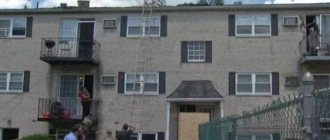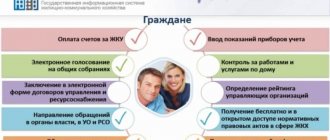Legislation
A housing partnership is one of the forms of management of urban apartment buildings and surrounding areas.
The creation, reorganization and liquidation of housing associations occurs with the direct participation of the owners of the premises and is regulated by the following standards:
- Chapter 13 of the Housing Code of the Russian Federation,
- Art. 57 , 61 of the Civil Code of the Russian Federation,
- Art. 21 Federal Law No. 129 “On state registration of legal entities.”
Subjects of the federation may adopt additional regulations governing the dissolution of HOAs, taking into account regional characteristics.
The procedure for the reorganization and liquidation of housing associations is also prescribed in the charter of a particular organization , and the provisions of the charter cannot contradict legislative norms.
Reorganization and liquidation: what is the difference?
Reorganization of a housing association means a change in the name or type of legal entity with the transfer of all obligations from the previous organization to the new one.
An example of a reorganization would be:
- merger of several partnerships,
- division of a large HOA into several separate structures,
- transformation of a housing association into a housing cooperative,
- separation of a separate organization from the HOA,
- joining the HOA of another partnership.
Reorganization votes , or a court decision.
The main difference between liquidation and reorganization is that during liquidation, the rights and obligations of the liquidated legal entity do not transfer to any of the newly formed house organizations.
Debts and obligations of the structure during liquidation also cannot be transferred to the new organization, but must be satisfied.
Liquidation of HOA
The grounds for liquidation of a housing association may be:
- decision of the owners of premises in the house,
- housing inspection petition,
- the court's decision,
- illegality of creation,
- bankruptcy.
Owners of premises can reorganize or liquidate the HOA at a general meeting convened by the initiative team.
The reasons for liquidation by decision of the owners are often the desire to transfer the house to a management company due to the incompetence of the HOA management in matters of supplying utilities.
Read the article about what the responsibilities of a management company for repairs and housing and communal services of apartment buildings are.
The Housing Inspectorate sends a petition to the court or the tax service to liquidate the housing association if its management repeatedly violates housing legislation.
The illegality of creating a housing partnership is manifested in the provision of false constituent documents or violations in the conduct of voting on the creation of a partnership.
The most common violation when creating a housing association, leading to its immediate liquidation, is voting without a quorum , or its inaction.
In this case, the residents of the house, whose opinions were not taken into account, send a corresponding complaint to the housing supervision authority , and based on the results of the inspection, the organization is liquidated as illegal.
Download a sample complaint against an HOA to the Housing Inspectorate here.
The following documents will be required for liquidation:
- statement from the initiators of liquidation,
- accounting certificate confirming the liquidation account,
- receipt of payment of the liquidation fee,
- certificate from the pension fund,
- a court decision or minutes of a meeting of premises owners (owners of the HOA),
- copies of passports of liquidation commission participants,
- copies of statutory documents.
The liquidation application must be drawn up in form P16001, approved by Order of the Tax Service No. 7-6/25 .
Application form for liquidation of a legal entity.
The text must reflect the passport details of the initiators of liquidation and their place of registration, as well as notification of the date of publication of the liquidation announcement in the media.
Sample of filling out a notice of liquidation of a legal entity. faces.
Liquidation by decision of the owners
There is an option in which the partnership will be closed by a general meeting of all owners according to the protocol. But for this you need to collect more than half of all votes. Although this will not be possible if the HOA has debts to the state or utility and repair services. Then you must first pay off the debt or liquidate the cooperative with the help of the court.
Then the process will go like this:
- At the general meeting, the issue of closure is decided, the members of the commission are determined;
- A protocol is drawn up indicating the deadlines and members of the commission;
- After at least three days, services such as the tax and registration chamber must be notified of the decision;
- The commission makes an announcement in the magazine that creditors can declare their rights, but this period is no more than three months;
- Drafting a letter for creditors and sending it out.
Over the next two months, a document is drawn up that describes all the enterprise’s real estate, debts, the cooperative’s balance sheet, and the distribution of debts among all creditors. Next, all documentation is transferred to the tax office.
Methods
There are three main ways to liquidate a housing association:
- by decision of the general meeting of the partnership participants,
- by decision of the meeting of owners of apartment buildings,
- by decision of the judicial authorities.
The method of liquidation depends both on the legitimacy of the functioning of the housing association and on the initiator of liquidation, as well as the grounds that arose for this procedure.
Meeting of HOA members
For the decision on liquidation to be legal, at least half of all members of the housing association must be present at the general meeting.
The decision is made by a simple majority of votes (50% plus one vote).
The meeting is convened in the manner prescribed by the charter, after which the chairman and secretary of the meeting are elected from among the members of the board or initiative group, if the board prevents the liquidation of the partnership.
At the meeting, the chairman announces the agenda and puts the issue of liquidating the HOA to a vote .
The secretary keeps minutes of the meeting and notes the number of voters for each agenda item. Participants in the gathering can vote for , against , or abstain from voting .
The agenda cannot include issues that were not announced at the stage of convening the meeting.
When liquidating an HOA, the agenda list is as follows:
- the question of liquidation,
- the issue of electing a liquidation commission,
- the issue of settlements with creditors and the transfer of HOA property into the common ownership of the owners of the premises of the house.
Based on the voting results, the chairman certifies the protocol with his signature.
Sample minutes of the general meeting of HOA members.
The text of the protocol must contain:
- name of the HOA and locality,
- information about the date and place of the meeting,
- list of agenda items,
- information about the voting members of the HOA,
- Full name of the chairman and secretary of the meeting,
- data on the presence of quorum,
- special marks.
Each of the meeting participants has the right to demand that their dissenting opinion be included in the minutes on the agenda items discussed.
By decision of the owners
Liquidation by decision of the collection of apartment owners of the building occurs if the members of the HOA own less than half of the total living space of the apartment building, in accordance with clause 2 of Art. 141 Housing Code .
Article 141. Liquidation of a homeowners' association 1. The liquidation of a homeowners' association is carried out on the basis and in the manner established by civil legislation.
2. The general meeting of owners of premises in an apartment building is obliged to make a decision on the liquidation of the partnership of homeowners if the members of the partnership do not have more than fifty percent of the votes of the total number of votes of the owners of premises in the apartment building.
For liquidation by decision of the owners, the presence of the owners of at least half of all square meters belonging to the HOA being liquidated must be present at the meeting.
To organize a meeting, at least 10% of the owners must contact the authorized body of the HOA with a request to provide premises for the meeting and its organization ( clause 6 of Article 45 of the Housing Code of the Russian Federation ).
To liquidate an HOA, the owners must draw up minutes of the general meeting and vote on the agenda items; liquidation is recognized if more than half of those present vote in favor.
Unlike the meeting of HOA members, the meeting of premises owners has broader powers, and in addition to liquidation, it can include on the agenda the following issues:
- on the creation of a new partnership or cooperative,
- about choosing a different way to manage the house.
Voting of premises owners regarding the liquidation of the HOA can occur either at a meeting or in absentia .
Absentee voting is chosen when the number of owners is more than 100 people and it is not possible to collect a quorum at the same time.
During absentee voting, ballots are formed for each owner, after which an initiative group of at least two people makes a door-to-door tour of the houses belonging to the partnership.
Then residents fill out the columns opposite each agenda item on the ballot, putting their signature in the items “for” , “against” or “abstained” .
Judicial resolution of the issue
When smooth closure cannot be accomplished, another way to solve the problem is required. We are talking about liquidation through the courts. In such a situation, members of the association must create an initiative group whose task is to conduct propaganda work. The ultimate goal is that the number of owners wishing to liquidate should be more than half of the total number of residents. Those who have expressed consent to the abolition of the organization submit a written application for exclusion from the association.
As soon as the created campaign group achieves its final goal and a quorum of HOA members who want to terminate the existence of the organization is assembled, it is time to file a class action lawsuit. Comments from lawyers competent in this matter will help to correctly file a statement of claim. The court may satisfy the claim, after which a liquidation commission is created accordingly. Sometimes representatives of other organizations are involved in the case. The presented step-by-step instructions are brief; resolving the issue through the court involves a fairly long path and many pitfalls.
Step-by-step instruction
To liquidate the partnership, the initiators must take the following actions:
- Make a decision on liquidation at a general meeting,
- Submit an announcement in the media about the liquidation of the HOA,
- Create a liquidation commission,
- Close obligations to creditors,
- Contact the tax service with an application for liquidation of the HOA,
- If it is impossible to convene a meeting, it is necessary to obtain a court decision on liquidation.
Advertisements in the media are submitted to satisfy the demands of creditors , since the moment the decision on liquidation is made is the basis for the collection of debts ( clause 4 of Article 61 of the Civil Code of the Russian Federation ).
The announcement must contain the date from which creditors can begin collection of debts; the start date for collection must be at least 60 days .
During this period, the liquidation commission:
- balances the partnership
- sells off his property
- pays off with creditors.
It is important to take into account that the liquidation organizers are responsible with personal property for settlements with creditors, but in the case of an HOA, these costs are borne by those responsible for the embezzlement .
Moreover, if it is impossible to collect debts from them , they are distributed among all owners of the premises in proportion to the square meters occupied.
After the closure of obligations to creditors, an application is submitted to the tax authority in form P16001 with documents indicating the repayment of debts to creditors and a copy of the decision on the liquidation of the HOA.
If there are no violations of the liquidation procedure within 5 working days after filing the application, the HOA is deregistered from the unified register of legal entities.
To learn how to deal with an unscrupulous HOA, watch the video:
How to liquidate an HOA with debts: basic principles
- Violations of current legislation when creating a partnership and during its existence;
- Ineffective activities that led to the emergence of significant debt to counterparties;
- Lack of activity;
- Lack of the required number of HOA participants.
Next, the agenda items on the liquidation of the HOA are put to a vote and after the votes are counted, a protocol is drawn up, which notes all the details of the meeting, including the decisions made. After this, the step-by-step liquidation of the HOA requires mandatory notification to the territorial body of the Federal Tax Service about the decision made. The notice must be drawn up in accordance with the approved requirements. The notification is signed by the chairman of the meeting (an authorized person), and the signature must be notarized. The package of documents for the Federal Tax Service includes the notification itself and one copy of the minutes of the general meeting. The instructions for liquidating an HOA or TSN (real estate owners' association) advise doing the same. In a general sense, the liquidation procedures for HOAs and TSNs are absolutely identical for each of these forms of partnerships.
We recommend reading: Help 2 Personal Income Tax 2020 Sample
What needs to be done after liquidation?
After the liquidation procedure, premises owners must choose a method for managing the common property of an apartment building.
Management can be carried out:
- licensed management organization (MC),
- housing association or cooperative,
- directly by the owners of the premises.
Owners can manage a house without creating a legal entity if the number of apartments in the house does not exceed 50.
In most cases, the reason for the liquidation of a partnership is the presence of large debts to resource supply organizations (water utilities, district heating, etc.) or violations and waste on the part of the previous management.
Read about how to check whether utility bills are calculated correctly here.
anti-crisis may be appointed to put the common property in order after the liquidation of the homeowners’ association .
The involvement of an anti-crisis manager after the liquidation of the HOA occurs by decision of the owners at a general meeting.
The anti-crisis manager has experience in communicating with creditors, resource suppliers and is an experienced business executive.
The contract is signed for a limited period (2-4 months), during which the involved manager:
- resolves issues with creditors,
- arranges the supply of utility resources,
- recruits full-time employees for the partnership,
- trains future leadership.
After the end of the work of the former manager, the owners of the premises legally register a new housing association or cooperative , recruiting the formed team and a manager from among the responsible residents.
The Audit Commission and its powers
The Audit Commission is the elected supervisory body of the housing association and consists of one auditor or several commission members, depending on the size of the HOA.
According to the provisions of Art. 150 of the Housing Code of the Russian Federation , the duties of the audit commission include:
- annual audit of the financial documentation of the HOA,
- checking financial statements,
- drawing up a conclusion on the annual income and expenditure budget of the HOA,
- reporting to residents who are members of the association.
If members of the commission, during their inspections, discover abuses on the part of management or the activities of hired specialists, then the auditors send a demand to management to eliminate the violations .
If the commission’s requirements are ignored, its members draw up a report of violations and send it to the local housing supervision authority.
The supervisory authority has the right to initiate an appeal to the court with the aim of liquidating the HOA or forcibly removing its management.
The Audit Commission also has the right:
- go to court with a demand to liquidate or reorganize the HOA,
- convene a general meeting to report to residents about management violations and decide the future fate of the HOA.
The Audit Commission is elected from among the owners of premises at general meetings for a period of 2 years.
It is important to take into account that the commission cannot include elected members of the board of directors of the partnership .
Special cases
Liquidation of a housing association often occurs when there are debts .
Before removing the HOA from registration, the liquidation commission must pay off all existing debts .
Otherwise, liquidation is possible only through an arbitration court with the organization declared bankrupt .
The judicial authorities make decisions in order to protect the interests of property owners and creditors .
When liquidating an HOA with debts, the court appoints a bankruptcy arbitration manager for a period of no more than 6 months .
During this period, the arbitration manager:
- reorganizes the activities of the partnership in order to reduce costs ,
- draws up a plan for settlements with creditors,
- organizes the collection of debts from debtor residents for housing and communal services,
- prepares the HOA for liquidation .
The court gives the arbitration manager unlimited powers to manage the partnership.
After full or partial settlement with creditors within the period allotted by the court, a second meeting takes place, at which a final decision is made to liquidate the partnership .
If the members of the liquidation commission do not have the funds to organize the liquidation process, then they submit a corresponding application to the tax authority so that the actually non-operating legal entity is excluded from the register.
Audit
The audit commission plays an important role in the work of the HOA. She is responsible for monitoring the financial activities of the partnership.
To ensure the normal functioning of the commission, the accountant regularly transmits the necessary information and documents.
The Audit Commission is elected at a meeting of owners. The range of its rights and obligations is determined by the laws of the Russian Federation and the charter.
The audit can be regular (once a year) and extraordinary (by decision of the HOA members).
During the inspection, the following activities are carried out:
- studying documents on the financial activities of the HOA and information on the inventory;
- comparison of the obtained data with those indicated in the primary accounting documents;
- identifying the legality of concluded contracts and calculations made;
- analysis of accounting and financial activities;
- checking compliance with legislation, timely payment of funds to the budget, and submission of reports to the tax authorities.
The audit commission is of great importance in the work of the partnership. She controls the financial activities of the HOA. The accountant regularly provides information and regulatory documents to the HOA so that the commission works normally.
The commission is elected by a meeting of owners, its term of activity is no more than 2 years. Members of the commission do not have the right to be members of the management of the partnership. Its competence is stated in the legislation and charter, and its work procedure is in the document approved by the meeting.
Checks can be carried out:
- Based on the results for the whole year.
- At any time, if the members of the partnership require it at a meeting, or the board of the partnership decides to conduct an inspection.
- She may also request a special meeting to discuss the results of the work done.
Functions
- Checking HOA documents on finances and property inventory data.
- Comparison with primary accounting documents.
- Checking contracts and settlements with counterparties for legality.
- Accounting analysis.
- Checking compliance with the rules and regulations of the financial activities of the HOA.
- Analysis of the financial situation, ability to make payments, liquidity of the HOA assets.
- Verification of payments to the state budget on time.
- Checking reports for the tax authority.
- Verification of the competence of decisions made by HOA officials, compliance with the Charter and decisions of the partnership meeting.
- Development of recommendations for the management of the partnership.
Checking act
The commission reflects the results of the work carried out in its report. It contains sections such as:
- General provisions - the composition of the commission, the timing of the inspection and all the persons involved in its work.
- Information about the condition of the property.
- Checking documents of cash and advance reports.
- Checking bank documents.
- Accrual and payment of salary.
- Admission
- finance in the form of income.
- Organization of HOA tariff plan policy.
- HOA debt.
- Table with discrepancies between cost and income estimates.
- Pivot tables.
- Evaluation of the work of the management bodies of the partnership.
- Your conclusions and recommendations.
A sample is available here.
- Conducting scheduled audits of the HOA’s work throughout the year.
- Preparation of a conclusion on the draft estimate, amounts of payments and contributions for the year.
- Consideration of complaints and letters from members of the partnership.
- Informing about the results of all inspections carried out by the management bodies of the partnership within 10 days after them.
- Report on your work before the meeting.
Position
The regulations on the commission are developed in accordance with the Housing Legislation and the HOA Charter. It states:
- general provisions governing the activities of the HOA commission;
- goals and objectives of the commission;
- the procedure for electing the chairman and members working in the commission;
- rights with responsibilities;
- the procedure for holding meetings and audits;
- storage of documents;
- notifying the members of the partnership about your decision;
- financial support for the work of the commission.









